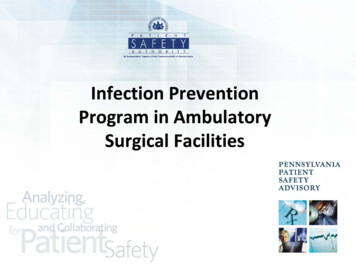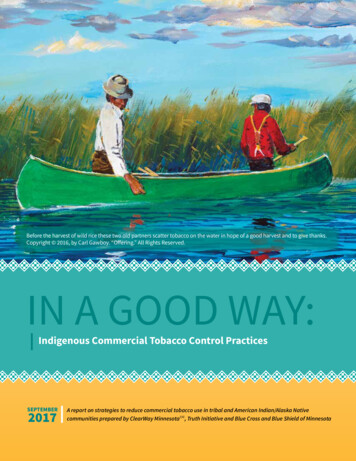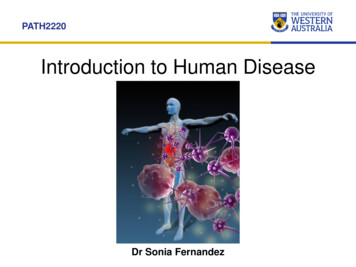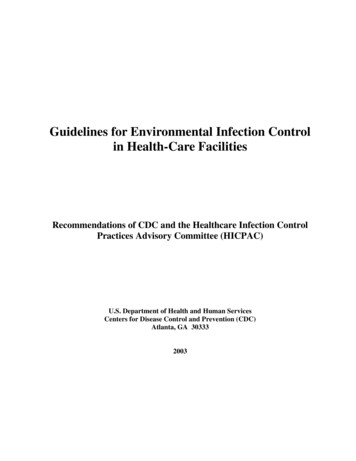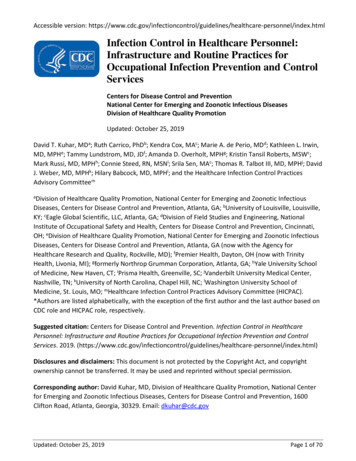
Transcription
Accessible version: althcare-personnel/index.htmlInfection Control in Healthcare Personnel:Infrastructure and Routine Practices forOccupational Infection Prevention and ControlServicesCenters for Disease Control and PreventionNational Center for Emerging and Zoonotic Infectious DiseasesDivision of Healthcare Quality PromotionUpdated: October 25, 2019David T. Kuhar, MDa; Ruth Carrico, PhDb; Kendra Cox, MAc; Marie A. de Perio, MDd; Kathleen L. Irwin,MD, MPHe; Tammy Lundstrom, MD, JDf; Amanda D. Overholt, MPHg; Kristin Tansil Roberts, MSWc;Mark Russi, MD, MPHh; Connie Steed, RN, MSNi; Srila Sen, MAc; Thomas R. Talbot III, MD, MPHj; DavidJ. Weber, MD, MPHk; Hilary Babcock, MD, MPHl; and the Healthcare Infection Control PracticesAdvisory CommitteemaDivisionof Healthcare Quality Promotion, National Center for Emerging and Zoonotic InfectiousDiseases, Centers for Disease Control and Prevention, Atlanta, GA; bUniversity of Louisville, Louisville,KY; cEagle Global Scientific, LLC, Atlanta, GA; dDivision of Field Studies and Engineering, NationalInstitute of Occupational Safety and Health, Centers for Disease Control and Prevention, Cincinnati,OH; eDivision of Healthcare Quality Promotion, National Center for Emerging and Zoonotic InfectiousDiseases, Centers for Disease Control and Prevention, Atlanta, GA (now with the Agency forHealthcare Research and Quality, Rockville, MD); fPremier Health, Dayton, OH (now with TrinityHealth, Livonia, MI); gformerly Northrop Grumman Corporation, Atlanta, GA; hYale University Schoolof Medicine, New Haven, CT; iPrisma Health, Greenville, SC; jVanderbilt University Medical Center,Nashville, TN; kUniversity of North Carolina, Chapel Hill, NC; lWashington University School ofMedicine, St. Louis, MO; mHealthcare Infection Control Practices Advisory Committee (HICPAC).*Authors are listed alphabetically, with the exception of the first author and the last author based onCDC role and HICPAC role, respectively.Suggested citation: Centers for Disease Control and Prevention. Infection Control in HealthcarePersonnel: Infrastructure and Routine Practices for Occupational Infection Prevention and ControlServices. 2019. ealthcare-personnel/index.html)Disclosures and disclaimers: This document is not protected by the Copyright Act, and copyrightownership cannot be transferred. It may be used and reprinted without special permission.Corresponding author: David Kuhar, MD, Division of Healthcare Quality Promotion, National Centerfor Emerging and Zoonotic Infectious Diseases, Centers for Disease Control and Prevention, 1600Clifton Road, Atlanta, Georgia, 30329. Email: dkuhar@cdc.govUpdated: October 25, 2019Page 1 of 70
Infection Control in Healthcare Personnel:Infrastructure and Routine Practices for Occupational Infection Prevention and Control ServicesTable of ContentsExecutive Summary .5Introduction .7Scope and purpose .7Rationale.8Audience .9Definitions .9Methods .9References . 101. Leadership and Management. 11Background . 11Recommendations. 13References . 142. Communication and Collaboration . 17Background . 17Recommendations. 18References . 183. Assessment and Reduction of Risks for Infection among Healthcare Personnel Populations. 22Background . 22Recommendations. 24References . 244. Medical Evaluations. 27Background . 27Recommendations. 29References . 305. Occupational Infection Prevention and Control: Education and Training. 31Background . 31Recommendations. 32Updated: October 2019Page 2 of 70
Infection Control in Healthcare Personnel:Infrastructure and Routine Practices for Occupational Infection Prevention and Control ServicesReferences . 336. Immunization Programs . 35Background . 35Recommendations. 37References . 377. Management of Potentially Infectious Exposures and Illnesses . 39Background . 39Recommendations. 42References . 448. Management of Healthcare Personnel Health Records . 46Background . 46Recommendations. 48References . 49Appendix 1. Contributors . 51Appendix 2. Terminology. 53Appendix 3. Methods . 56Updated: October 25, 2019Page 3 of 70
Infection Control in Healthcare Personnel:Infrastructure and Routine Practices for Occupational Infection Prevention and Control ServicesList of Boxes, Tables, and FiguresBoxes:Box 1. Examples of Performance Measures that Might Be Used to Assess the Effectiveness ofOccupational Infection Prevention and Control Services . 16Box 2. Examples of Possible Areas of Collaboration for Occupational Infection Prevention and ControlServices . 19Box 3. Examples of Hazard Identification, Risk Assessment, and Risk Reduction Activities in whichOccupational Health Services Might Participate . 26Box 4. Examples of Federal Regulations Requiring Education and Training for Employees . 34Tables:Table A3.1 First Search Strategy for Indexed Articles Published January 2004-October 2015, byDatabase . 59Table A3.2 Second Search Strategy for Indexed Articles Published January 2004-December 2015, byDatabase . 61Table A3.3 Third Search Strategy for Articles Published January 2004-December 2015 that wereIndexed in Cochrane Database of Systematic Reviews . 63Table A3.4 Fourth Search Strategy for Indexed Articles about Immunization Programs for HealthcarePersonnel Published January 2004-December 2015, by Database . 64Table A3.5 Websites Examined for Government Regulations, Standards, Guidelines, and Other Reportsabout Occupational Infection Prevention and Control among Healthcare Personnel. 65Figures:Figure 1. Hierarchy of Controls . 23Figure A3.1. Results of the Process to Select Relevant Articles . 70Updated: October 2019Page 4 of 70
Infection Control in Healthcare Personnel:Infrastructure and Routine Practices for Occupational Infection Prevention and Control ServicesExecutive SummaryThis document, Infection Control in Healthcare Personnel: Infrastructure and Routine Practices forOccupational Infection Prevention and Control Services, is an update of four sections of Part I of theGuideline for infection control in health care personnel, 1998 (“1998 3) and their corresponding recommendations in Part II: C.Infection Control Objectives for a Personnel Health Service; D. Elements of a Personnel Health Servicefor Infection Control; H. Emergency-Response Personnel; and J. The Americans With Disabilities Act.Recommendations in the other sections of the 1998 Guideline are current.Those sections described the infrastructure and routine practices of Occupational Health Services(OHS) for providing occupational infection prevention and control (IPC) services to healthcarepersonnel (HCP), as well as special considerations associated with emergency response personnel andprovisions in the Americans with Disabilities Act (ADA) that are relevant to OHS.The updated recommendations in this document are aimed at the leaders and staff of OHS and theadministrators and leaders of healthcare organizations (HCO) and are intended to facilitate theprovision of occupational IPC services to HCP. The recommendations address eight IPC elements ofOHS:1.2.3.4.5.6.7.8.Leadership and managementCommunication and collaborationAssessment and reduction of risks for infection among HCP populationsMedical evaluationsOccupational IPC education and trainingImmunization programsManagement of potentially infectious exposures and illnessesManagement of HCP health recordsIn this document, “OHS” is used synonymously with “Employee Health,” “Employee Health Services,”“Employee Health and Safety,” “Occupational Health,” and other such programs. OHS refers to thegroup, department, or program that addresses many aspects of health and safety in the workplace forHCP, including the provision of clinical services for work-related injuries, exposures, and illnesses. Inhealthcare settings, OHS addresses workplace hazards including communicable diseases; slips, trips,and falls; patient handling injuries; chemical exposures; HCP burnout; and workplace violence.The term “HCP” refers to all paid and unpaid persons serving in healthcare settings who have thepotential for direct or indirect exposure to patients or infectious materials, including body substances;contaminated medical supplies, devices, and equipment; contaminated environmental surfaces; orUpdated: October 25, 2019Page 5 of 70
Infection Control in Healthcare Personnel:Infrastructure and Routine Practices for Occupational Infection Prevention and Control Servicescontaminated air. For this document, HCP does not include dental healthcare personnel, autopsypersonnel, and clinical laboratory personnel, as recommendations to address occupational IPC forthese personnel are available elsewhere.The term “healthcare settings” refers to places where healthcare is delivered and includes, but is notlimited to, acute care facilities, long-term acute care facilities, inpatient rehabilitation facilities, nursinghomes and assisted living facilities, home healthcare, vehicles where healthcare is delivered (e.g.,mobile clinics), and outpatient facilities, such as dialysis centers, physician offices, and others.The infrastructure and delivery of healthcare to patients, and hence the provision of occupational IPCservices to HCP, has changed since the publication of the 1998 Guideline. The recommendations in thisdocument update the 1998 Guideline recommendations with: a broader range of elements necessary for providing occupational IPC services to HCP;applicability to the wider range of healthcare settings where patient care is now delivered,including hospital-based, long-term care, and outpatient settings such as ambulatory and homehealthcare; andexpanded guidance on policies and procedures for occupational IPC services and strategies fordelivering occupational IPC services to HCP.New topics include: administrative support and resource allocation for OHS by senior leaders and management,service oversight by OHS leadership, anduse of performance measures to track occupational IPC services and guide quality improvementinitiatives.The recommendations are informed by a systematic literature review of recent articles consistent withcurrent approaches in occupational IPC service delivery to HCP published in peer-reviewed journals orrepositories of systematic reviews from January 2004-December 2015 and a review of occupational IPCguidelines, regulations, and standards. The recommendations are classified as good practicestatements based upon the expert opinions of the authors and the Healthcare Infection ControlPractices Advisory Committee (HICPAC).Abbreviations: ADA, Americans with Disabilities Act; HCO, Healthcare Organization; HCP, HealthcarePersonnel; HICPAC, Healthcare Infection Control Practices Advisory Committee; IPC, InfectionPrevention and Control; OHS, Occupational Health ServicesUpdated: October 25, 2019Page 6 of 70
Infection Control in Healthcare Personnel:Infrastructure and Routine Practices for Occupational Infection Prevention and Control ServicesIntroductionScope and purposeThe prevention of infectious disease transmission among HCP and patients is a critical component ofsafe healthcare delivery in all healthcare settings. OHS provides occupational IPC expertise to an HCOand services to HCP, such as those aimed at reducing risks for acquiring infections on the job (e.g.,immunizing HCP) and managing HCP infectious exposures and illnesses that prevent the transmissionof infectious diseases from potentially infectious HCP to patients, HCP, and others.In 1998, the Centers for Disease Control and Prevention (CDC) published Guideline for infection controlin health care personnel, 1998,1 which provided information and recommendations for OHS on theprevention of transmission of infectious diseases among HCP and patients. This update, InfectionControl in Healthcare Personnel: Infrastructure and Routine Practices for Occupational InfectionPrevention Services, supersedes four sections of Part I of the 1998 Guideline and their correspondingrecommendations in Part II: C. Infection Control Objectives for a Personnel Health Service; D. Elementsof a Personnel Health Service for Infection Control; H. Emergency-Response Personnel; and J. TheAmericans With Disabilities Act. The updated recommendations are intended to facilitate the provisionof occupational IPC services to HCP and prevent transmission of infections between HCP and others.Additional updates to the 1998 Guideline address the epidemiology and control of selected infectionstransmitted among HCP and patients and considerations for special HCP populations.Recommendations in the other sections of the 1998 Guideline are current.This document does not address non-infectious elements of occupational health, such as slips, tripsand falls; patient handling injuries; chemical exposures; HCP burnout; and workplace violence. It doesnot provide recommendations on immunizations indicated for HCP, criteria for HCP evidence ofimmunity, or immunization practice recommendations, which are maintained by the AdvisoryCommittee on Immunization Practices (ACIP) tml).2,3 Services typically provided by IPC services or programs other than OHS, such asproviding access to recommended personal protective equipment (PPE) at the worksite, purchasingmedical equipment and safety technology, and providing engineering controls, are not addressed inthis document. This document does not describe all federal, state, and local requirements related tooccupational infection prevention and control, such as those maintained by the Occupational Safetyand Health Administration (OSHA).4-6Infection prevention and control objectives for an occupational health serviceOHS objectives for IPC generally include: supporting an HCO safety culture;adhering to federal, state, and local requirements for occupational health and reporting;Updated: October 25, 2019Page 7 of 70
Infection Control in Healthcare Personnel:Infrastructure and Routine Practices for Occupational Infection Prevention and Control Services collaborating with others (e.g., facility IPC services) to monitor and investigate potentiallyinfectious exposures, illnesses, and outbreaks involving HCP;identifying work-related infection risks and collaborating to institute appropriate risk reductionand preventive measures;providing HCP preventive measures (e.g., immunizations) and care for occupational exposuresor illnesses;educating and training HCP about the principles of exposure (e.g., sharps injuries) and infectionprevention;reducing absenteeism, illness, and disability among HCP; andensuring confidentiality of HCP information consistent with federal, state, and localrequirements.Infection prevention and control elements of an occupational health serviceThe organizational structure of an OHS depends on the size of its parent HCO, the number of facilitiesserved, the setting (e.g., inpatient- or outpatient-based), the numbers of HCP served, HCP job dutiesand possible associated exposures, and whether the services provided are on-site or off-site.Regardless of the structure of an OHS, program responsibilities include:1.2.3.4.5.6.7.8.Leadership and managementCommunication and collaborationAssessment and reduction of risks for infection among populations of HCPMedical evaluationsOccupational IPC education and trainingImmunization programsManagement of potentially infectious exposures and illnessesManagement of HCP health recordsRationaleThis update is intended to: address needs related to the growing diversity in models for providing occupational IPC servicesin healthcare settings (e.g., off-site service delivery);assist OHS to meet new regulatory requirements and standards from federal, state, and localjurisdictions, accreditation agencies, payers, and purchasers; andprovide guidance on how to conduct performance measurement and quality improvementactivities in the delivery of occupational IPC services.Updated: October 25, 2019Page 8 of 70
Infection Control in Healthcare Personnel:Infrastructure and Routine Practices for Occupational Infection Prevention and Control ServicesAudienceThese recommendations are aimed at two groups: the leaders and staff of OHS who provideoccupational IPC services to HCP, and the administrators and leaders of HCO who provide resources forthe delivery and management of occupational IPC services. Other groups, such as IPC staff, humanresources departments, and regulatory compliance groups, also may find this document helpful.DefinitionsIn this document, the term “OHS” is used synonymously with “Employee Health,” “Employee HealthServices,” “Employee Health and Safety,” “Occupational Health,” and other such programs. OHS refersto the group, department, or program that addresses many aspects of health and safety in theworkplace for HCP, including the provision of clinical services for work-related injuries, exposures, andillnesses. In healthcare settings, OHS addresses workplace hazards including communicable diseases;slips, trips and falls; patient handling injuries; chemical exposures; HCP burnout; and workplaceviolence.“HCP” refers to all paid and unpaid persons serving in healthcare settings who have the potential fordirect or indirect exposure to patients or infectious materials, including body substances (e.g., blood,tissue, and specific body fluids); contaminated medical supplies, devices, and equipment;contaminated environmental surfaces; or contaminated air. These HCP include, but are not limited to,emergency medical service personnel, nurses, nursing assistants, physicians, technicians, therapists,phlebotomists, pharmacists, students and trainees, contractual staff not employed by the healthcarefacility, and persons not directly involved in patient care, but who could be exposed to infectiousagents that can be transmitted in the healthcare setting (e.g., clerical, dietary, environmental services,laundry, security, engineering and facilities management, administrative, billing, and volunteerpersonnel). In this document, HCP does not include dental healthcare personnel, autopsy personnel,and clinical laboratory personnel, as occupational IPC service recommendations for these groups areavailable elsewhere.7-9The term “healthcare settings” refers to places where healthcare is delivered and includes, but is notlimited to, acute care facilities, long-term acute care facilities, inpatient rehabilitation facilities, nursinghomes and assisted living facilities, home healthcare, vehicles where healthcare is delivered (e.g.,mobile clinics), and outpatient facilities, such as dialysis centers, physician offices, and others.MethodsThe methods for the development of the recommendations in this document are described inAppendix 3. Methods.Updated: October 25, 2019Page 9 of 70
Infection Control in Healthcare Personnel:Infrastructure and Routine Practices for Occupational Infection Prevention and Control ServicesReferences1. Bolyard EA, Tablan OC, Williams WW, et al. Guideline for infection control in health carepersonnel, 1998. Hospital Infection Control Practices Advisory Committee [Erratum appears inInfect Control Hosp Epidemiol. 1998 Jul;19(7):493]. Infect Control Hosp Epidemiol. 1998Jul;19(6):407-63.2. Advisory Committee on Immunization Practices; Centers for Disease Control and Prevention.Immunization of health-care personnel: recommendations of the Advisory Committee onImmunization Practices (ACIP). MMWR Recomm Rep. 2011 Nov 25;60(RR-7):1-45.3. Schillie S, Murphy TV, Sawyer M, et al. CDC guidance for evaluating health-care personnel forhepatitis B virus protection and for administering postexposure management. MMWR RecommRep. 2013 Dec 20;62(RR-10):1-19.4. Standard 1910.1030 – Toxic and Hazardous Substances, Bloodborne .show document?p table standards&p id 10051). Occupational Safety and Health Administration. Revised April 3, 2012. Accessed August 20,2019.5. Standard 1910.134 – Respiratory p.show document?p id 12716&p table STANDARDS). Occupational Safety and Health Administration. Revised June 8, 2011. Accessed August20, 2019.6. Standard 1910.132 – General isp.show document?p id 9777&p table STANDARDS). Occupational Safety and Health Administration. Revised November 16, 2016. AccessedAugust 20, 2019.7. Kohn WG, Harte JA, Malvitz DM, et al. Guidelines for infection control in dental health-caresettings--2003. MMWR Recomm Rep. 2003 Dec 19;52(RR-17):1-61.8. Biosafety in Microbiological and Biomedical Laboratories, 5th /bmbl5/). Centers for Disease and Control andPrevention, National Institutes of Health. HHS Publication No. (CDC) 21-1112. EffectiveDecember 2009. Reviewed October 24, 2018. Accessed August 20, 2019.9. Miller JM, Astles R, Baszler T, et al; Biosafety Blue Ribbon Panel. Guidelines for safe workpractices in human and animal medical diagnostic laboratories. Recommendations of a CDCconvened, Biosafety Blue Ribbon Panel [Erratum appears in MMWR Surveill Summ. 2012 Mar30;61(12):214]. MMWR Suppl. 2012 Jan 6;61(1)1-102.Abbreviations: ACIP, Advisory Committee on Immunization Practices; CDC, Centers for Disease Controland Prevention; HCO, Healthcare Organization; HCP, Healthcare Personnel; IPC, Infection PreventionUpdated: October 25, 2019Page 10 of 70
Infection Control in Healthcare Personnel:Infrastructure and Routine Practices for Occupational Infection Prevention and Control Servicesand Control; OHS, Occupational Health Services; OSHA, Occupational Safety and Health Administration;PPE, Personal Protective Equipment1. Leadership and ManagementBackgroundLeader(s) of OHS oversee the delivery and monitor the quality of occupational IPC services. Planningand decision-making can be shared with other parts of the organization, including human resources,facility IPC services, facilities management, and environmental services. HCO leadership support forOHS leaders is critical for facilitating intra-organizational collaboration and the effective provision ofoccupational IPC services.OHS leaders improve the delivery and quality of occupational IPC services by: developing both routine and emergency response policies and procedures for occupational IPCservices,providing accountability for occupational IPC service delivery and quality,engaging in continuous quality improvement activities that improve OHS, and fostering collaboration with other departments or programs that address IPC. Ensuring the provision of high-quality occupational IPC services can have many benefits, including: improvement of HCP health, job satisfaction, and morale,1support for a HCO safety culture,prevention of HCP infections and enhancing the health of patients and others (e.g., co-workers,family members) with whom HCP interact, and economic savings for the OHS and HCO.The leadership and management of OHS vary widely depending on HCO structure, the location ofservices with respect to HCP served, facili
medical equipment and safety technology, and providing engineering controls, are not addressed in this document. This document does not describe all federal, state, and local requirements related to occupational infection prevention and control, such as those maintained by the Occupational Safety and Health Administration (OSHA). 4-6







